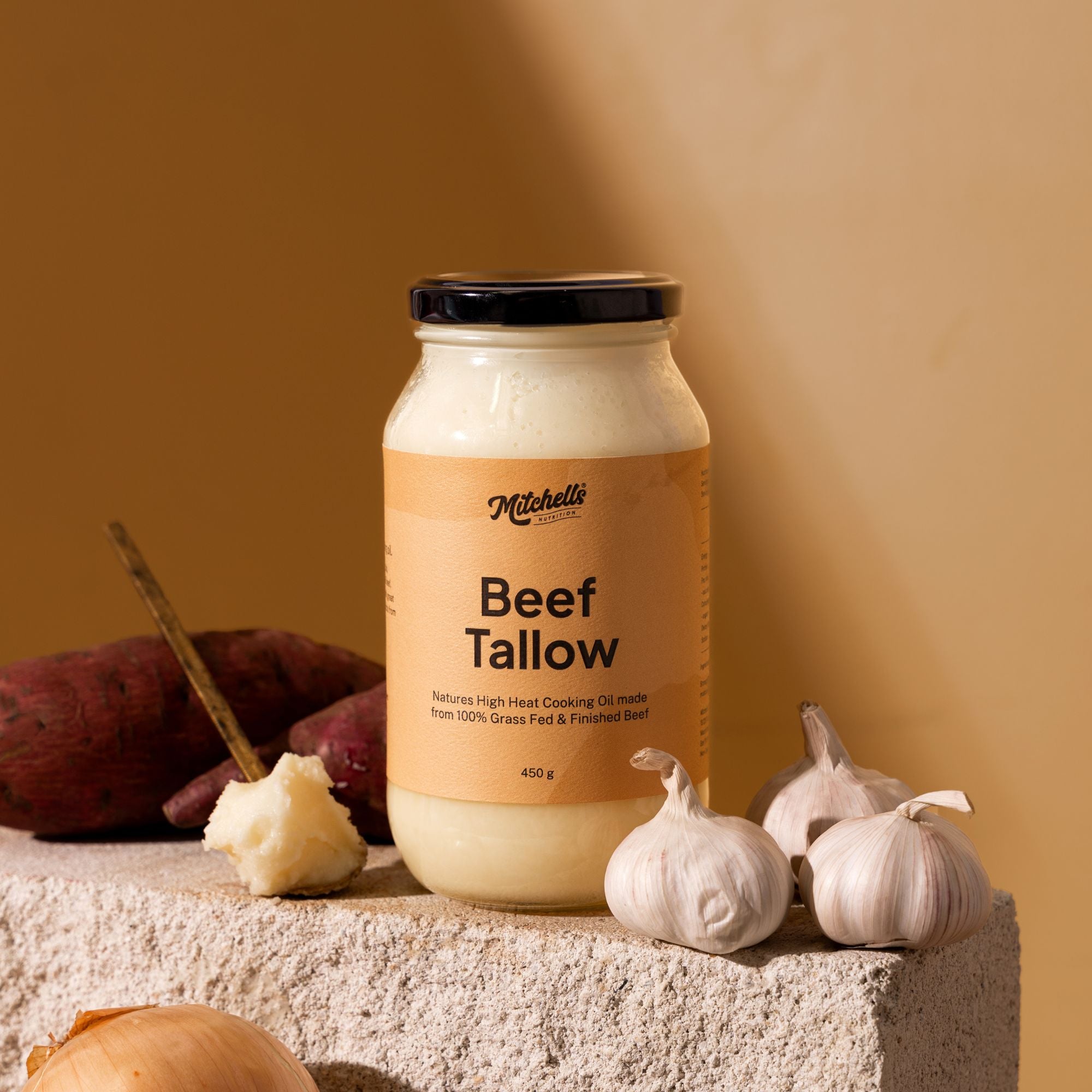




FAQ
What is Beef Tallow?
Beef tallow is the fat from cattle that has been rendered (melted down and purified). It's used primarily in cooking and frying because it has a high smoke point and adds rich flavor to dishes. Tallow is also used in soap-making, skincare products, and as a lubricant in various industrial processes.
How is beef tallow made?
To make beef tallow, beef fat is cut into small pieces and then slowly heated to melt the fat. The liquid fat is strained to remove any solid bits and impurities, leaving behind pure tallow. After the liquid cools, it solidifies into a firm, waxy texture.
What are the benefits of cooking with beef tallow?
- High Smoke Point: Beef tallow has a smoke point of around 400°F (204°C), making it ideal for high-heat cooking like frying and roasting
- Rich Flavour: It adds a depth of flavour to meals, particularly in dishes like fried potatoes, roasted meats, or stir-fries
- Nutritional Profile: Tallow contains mostly saturated fats, but it also has a good amount of monounsaturated fats and a small percentage of polyunsaturated fats. It’s a source of fat-soluble vitamins like Vitamin A, D, E, and K
- Stable at Room Temperature: Unlike vegetable oils, tallow is stable and doesn’t go rancid quickly, which makes it ideal for long-term storage. . . and better for your body!
How do I use beef tallow in cooking?
- Frying: Beef tallow is perfect for deep frying because it can handle high temperatures without being damaged and becoming detrimental to our health.
- Roasting and Baking: Use tallow for roasting vegetables or making pies. It can replace butter or oil in many recipes for a richer taste.
- Sautéing: For savoury dishes, sauté meats or vegetables in tallow for added depth of flavour.
- Seasoning Cast Iron: Tallow can also be used to season and maintain cast-iron pans.
Can I use beef tallow in place of butter or oil?
Yes, beef tallow can be used as a substitute for butter, lard, or vegetable oils in most cooking applications, especially where you want a heartier or richer flavour and healthier option. It’s great for making flaky pie crusts, for greasing pans, and caring for kitchen knives.
What’s the difference between tallow and lard?
While both tallow and lard are animal fats, tallow comes from beef (or other ruminant animals), whereas lard comes from pigs. Both fats are rendered in similar ways, but they have different flavours and fat compositions:
- Tallow tends to have a firmer, more waxy texture.
- Lard is usually softer and can have a milder flavour.
Can beef tallow be used for skincare?
Yes! Beef tallow is used in natural skincare products due to its nourishing properties. It contains vitamins A, D, and K, which are beneficial for skin health. Tallow can help moisturise dry skin and is often used in homemade soaps, balms, and lotions.
- Moisturising: Tallow is a great emollient and can help keep the skin soft and hydrated.
- Healing Properties: The vitamins and fatty acids in tallow can promote healing and reduce inflammation.
Is beef tallow suitable for people on a keto or paleo diet?
Yes! Beef tallow is often used in both ketogenic and paleo diets because it is a good source of fat without carbohydrates or sugars. It is ideal for cooking, as both diets emphasise high-fat, low-carb eating patterns.
Nutritional Information
Servings Per Jar: 32
Serve Size: 14g (1 Heaped Tablespoon)
| Avg. Qty. | Per Serve | Per 100g |
| Energy | 518 kJ | 3700 kJ |
| Protein, total | 0.0 g | 0.0 g |
| Fat, total | 13.9 g | 99.9 g |
| - saturated | 7.3 g | 52.2 g |
| Carbohydrate | 0.0 g | 0.0 g |
| - sugars | 0.0 g | 0.0 g |
| Dietary Fibre | 0.0 g | 0.0 g |
| Sodium | 0 mg | 0 mg |
Ingredients: Grass Fed & Finished Beef Tallow 100%.









